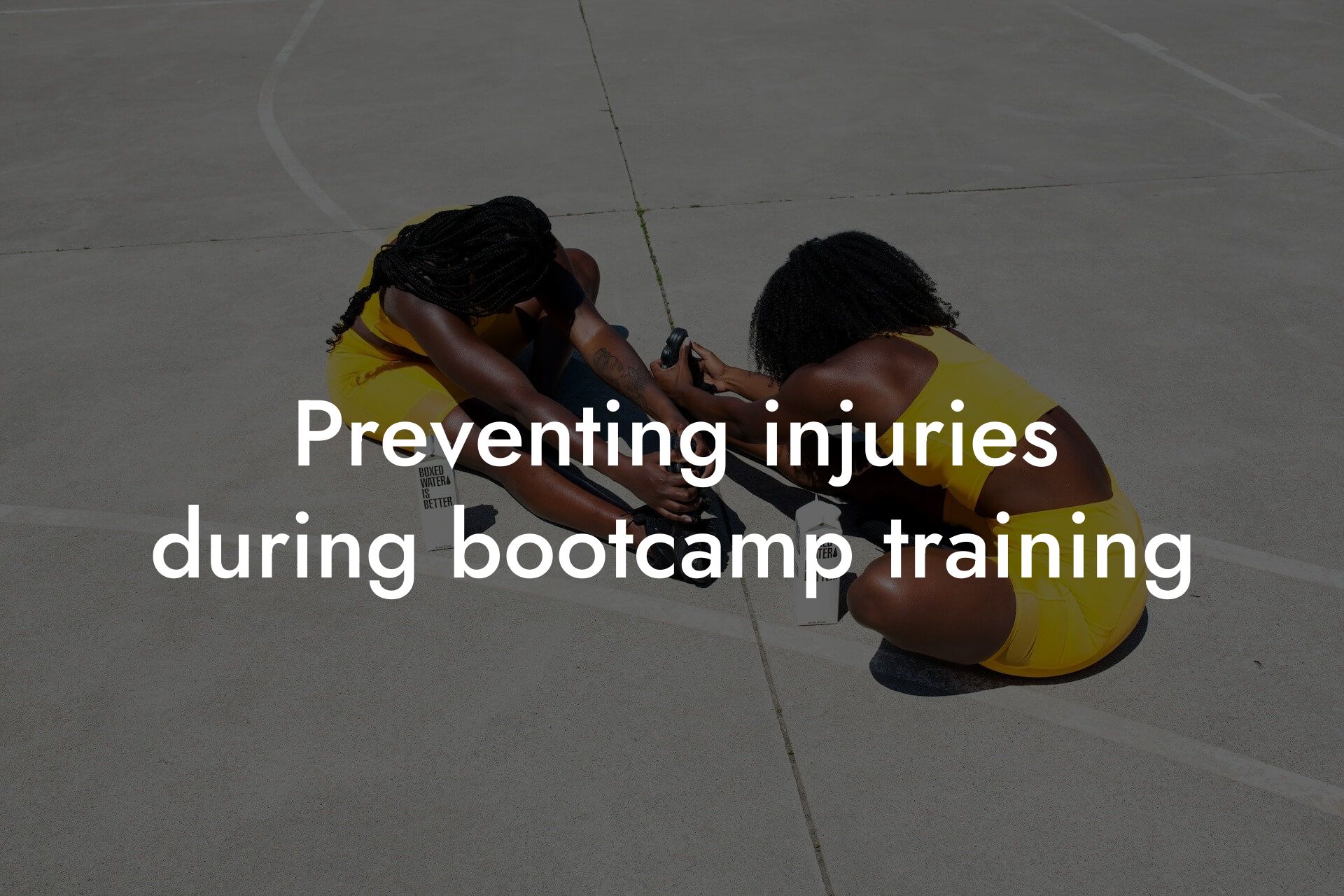As a high-earning professional, you understand the importance of maintaining a healthy and fit physique. Not only does it boost your confidence and energy levels, but it also enhances your overall well-being and ability to tackle the demands of your busy lifestyle. At Tano Performance Group, we're committed to providing you with the knowledge and tools you need to take your physical fitness to the next level. In this article, we'll dive into the world of bootcamp exercises and provide you with expert strength training tips to help you achieve your goals.
Table of Contents
- What are Bootcamp Exercises?
- Benefits of Strength Training for Bootcamp Exercises
- Warm-Up and Cool-Down Routines for Bootcamp Exercises
- Proper Form and Technique for Bootcamp Exercises
- Incorporating Progressive Overload for Bootcamp Exercises
- Periodization and Variation for Bootcamp Exercises
- Nutrition and Recovery for Bootcamp Exercises
- Tracking Progress and Setting Goals for Bootcamp Exercises
- Frequently Asked Questions
What are Bootcamp Exercises?
Bootcamp exercises are a type of high-intensity workout that combines elements of strength training, cardio, and agility exercises. They're designed to push your body to its limits, improving your overall fitness and athleticism. Bootcamp workouts typically involve a variety of exercises, such as burpees, jump squats, mountain climbers, and plank jacks, which are performed in quick succession with minimal rest time. This type of training is ideal for busy professionals who want to maximize their workout time and achieve rapid results.
Benefits of Strength Training for Bootcamp Exercises
Strength training is an essential component of any bootcamp workout. By building muscular strength and endurance, you'll be able to perform exercises with more power, speed, and agility. This, in turn, will help you burn more calories, increase your metabolism, and enhance your overall athletic performance. Additionally, strength training can help improve your bone density, reducing your risk of osteoporosis and fractures.
Warm-Up and Cool-Down Routines for Bootcamp Exercises
Before starting any bootcamp workout, it's essential to warm up your muscles to prevent injuries and improve performance. A dynamic warm-up routine should include exercises such as leg swings, arm circles, and torso twists. These exercises will increase blood flow to your muscles, reduce muscle tension, and prepare your body for the intense workout ahead. After your workout, a cool-down routine should focus on static stretches to help your body recover and rebuild.
Proper Form and Technique for Bootcamp Exercises
Proper form and technique are crucial when performing bootcamp exercises. Poor form can lead to injuries, ineffective workouts, and plateaus. To get the most out of your workout, focus on the following key elements: engage your core, keep your back straight, and use controlled movements. For example, when performing a burpee, start in a standing position, then drop down into a squat position, kick back into a plank position, do a push-up, quickly return your feet to the squat position, and stand up. Remember to breathe naturally and avoid holding your breath.
Incorporating Progressive Overload for Bootcamp Exercises
Progressive overload is a training principle that involves gradually increasing the intensity of your workouts over time. This can be achieved by adding weight, reps, or sets to your exercises. For bootcamp exercises, progressive overload can be incorporated by increasing the number of burpees, jump squats, or mountain climbers you perform in a row. You can also add weight to your exercises, such as wearing a weighted vest or using dumbbells. This will challenge your muscles and prevent plateaus.
Periodization and Variation for Bootcamp Exercises
Periodization and variation are essential for avoiding plateaus and preventing overtraining. Periodization involves dividing your workout routine into specific phases, each with a different focus or goal. For example, you may have a strength-building phase, a cardio-focused phase, and a recovery phase. Variation involves changing your workout routine to include different exercises, rep ranges, and intensities. This will keep your muscles guessing and prevent boredom.
Nutrition and Recovery for Bootcamp Exercises
A well-planned nutrition and recovery strategy is critical for optimal performance and muscle growth. Focus on consuming a balanced diet that includes lean protein, complex carbohydrates, and healthy fats. Aim to eat a post-workout meal or snack within 30-60 minutes of your workout to aid in muscle recovery. Additionally, prioritize rest and recovery days, as this is when your body repairs and rebuilds your muscles. Aim for 7-9 hours of sleep per night and take rest days as needed.
Tracking Progress and Setting Goals for Bootcamp Exercises
Tracking progress and setting goals are essential for staying motivated and achieving success in your bootcamp workout routine. Use a fitness tracker or mobile app to track your workouts, including the exercises you perform, the weight you lift, and the distance you cover. Set specific, measurable, and achievable goals, such as increasing your burpee count or reducing your body fat percentage. Regularly assess your progress and adjust your goals as needed.
At Tano Performance Group, we're committed to helping you achieve your fitness goals. Our state-of-the-art DEXA machine provides a comprehensive body assessment, giving you the insights you need to optimize your workout routine and nutrition strategy. Contact us today to learn more about our services and how we can help you take your physical fitness to the next level.
Frequently Asked Questions
What is the importance of strength training in bootcamp exercises?
Strength training is a crucial component of bootcamp exercises as it helps improve overall physical fitness, increases muscle mass, and boosts metabolism. It also enhances bone density, which is essential for high-earning professionals who want to maintain a healthy physique. Incorporating strength training into your bootcamp routine can help you achieve your fitness goals faster and more efficiently.
How often should I do strength training exercises in bootcamp?
Aim to do strength training exercises at least 2-3 times a week, with a minimum of 48 hours of rest in between. This allows your muscles to recover and rebuild, making them stronger over time. However, it's essential to listen to your body and adjust the frequency based on your individual needs and fitness level.
What are the best strength training exercises for beginners in bootcamp?
As a beginner, it's best to start with compound exercises that work multiple muscle groups at once. Some of the best strength training exercises for beginners in bootcamp include squats, lunges, push-ups, rows, and planks. These exercises are effective, easy to learn, and can be modified to suit your fitness level.
How do I incorporate strength training into my bootcamp routine?
To incorporate strength training into your bootcamp routine, start by adding 2-3 strength training exercises to your workout routine, 2-3 times a week. You can do these exercises before or after your cardio workout, depending on your preference. Make sure to warm up before starting your strength training exercises and cool down afterwards to prevent injuries.
What are the benefits of strength training for women in bootcamp?
Strength training is particularly beneficial for women in bootcamp as it helps increase bone density, reduces the risk of osteoporosis, and improves overall physical fitness. It also enhances muscle tone, boosts metabolism, and increases confidence. Additionally, strength training can help women in bootcamp achieve a more toned and lean physique.
Can I do strength training exercises at home for bootcamp?
Absolutely! You don't need to go to a gym to do strength training exercises for bootcamp. You can do bodyweight exercises like push-ups, squats, and lunges at home, or invest in a few pieces of equipment like dumbbells and resistance bands. There are also many online resources and workout videos that can guide you through strength training exercises at home.
How do I choose the right weight for strength training exercises in bootcamp?
When choosing the right weight for strength training exercises in bootcamp, start with a weight that allows you to complete the desired number of repetitions with proper form. If you're a beginner, start with lighter weights and gradually increase the weight as you build strength. Remember, it's better to start with a lighter weight and progress gradually than to risk injury by lifting too heavy.
What are the common mistakes to avoid in strength training for bootcamp?
Some common mistakes to avoid in strength training for bootcamp include poor form, lifting too heavy, not warming up or cooling down, and not giving your muscles enough rest time. It's also essential to avoid overtraining, which can lead to injury or burnout. Make sure to listen to your body and adjust your strength training routine accordingly.
How do I incorporate progressive overload into my strength training routine for bootcamp?
Progressive overload is a technique where you gradually increase the weight or resistance over time to continue challenging your muscles. To incorporate progressive overload into your strength training routine for bootcamp, aim to increase the weight by 2.5-5lbs every two weeks, or as soon as you feel you can handle more. This will help you continue making progress and achieving your fitness goals.
What are the best strength training exercises for building muscle in bootcamp?
Some of the best strength training exercises for building muscle in bootcamp include deadlifts, bench press, rows, and leg press. These exercises work multiple muscle groups at once and are effective for building muscle mass. Remember to always prioritize proper form and technique over the number of weights you lift.
How do I incorporate strength training into my busy schedule for bootcamp?
To incorporate strength training into your busy schedule for bootcamp, start by scheduling your workouts in your calendar and treating them as non-negotiable appointments. You can also try breaking up your strength training routine into shorter sessions, such as 20-30 minutes, and doing them during your lunch break or before bed. Consistency is key, so find a routine that works for you and stick to it.
What are the benefits of strength training for men in bootcamp?
Strength training is particularly beneficial for men in bootcamp as it helps increase muscle mass, boosts testosterone levels, and improves overall physical fitness. It also enhances bone density, reduces the risk of injury, and increases confidence. Additionally, strength training can help men in bootcamp achieve a more toned and lean physique.
Can I do strength training exercises with a partner or group for bootcamp?
Absolutely! Doing strength training exercises with a partner or group for bootcamp can be a great way to stay motivated, accountable, and engaged. You can work together to complete exercises, provide support and encouragement, and celebrate each other's progress. Many bootcamp programs also offer group strength training classes, which can be a fun and effective way to stay fit.
How do I track my progress in strength training for bootcamp?
To track your progress in strength training for bootcamp, take progress photos, measurements, and track your workouts. You can also use a fitness tracker or mobile app to monitor your progress and stay motivated. Remember to celebrate your small wins along the way and adjust your strength training routine as needed.
What are the best strength training exercises for improving bone density in bootcamp?
Some of the best strength training exercises for improving bone density in bootcamp include squats, lunges, deadlifts, and rows. These exercises work multiple muscle groups at once and are effective for building bone density. Remember to also incorporate exercises that target your core and glutes, as these are essential for overall bone health.
How do I incorporate strength training into my cardio workout for bootcamp?
To incorporate strength training into your cardio workout for bootcamp, try adding strength training exercises to your cardio routine, such as burpees, jump squats, or mountain climbers. You can also do strength training exercises during your active recovery periods, such as during a brisk walk or jog. This will help you make the most of your workout time and achieve your fitness goals faster.
What are the benefits of strength training for overall health and wellness in bootcamp?
Strength training is essential for overall health and wellness in bootcamp as it helps improve physical fitness, increases muscle mass, and boosts metabolism. It also enhances bone density, reduces the risk of injury, and improves mental health. Additionally, strength training can help you maintain a healthy weight, improve your sleep, and increase your energy levels.
Can I do strength training exercises with injuries or chronic pain in bootcamp?
If you have injuries or chronic pain, it's essential to consult with a healthcare professional or fitness expert before starting a strength training program in bootcamp. They can help you modify exercises to accommodate your injuries or chronic pain, and provide guidance on how to progress safely. Remember to prioritize your health and safety above all else.
How do I stay motivated and consistent with my strength training routine in bootcamp?
To stay motivated and consistent with your strength training routine in bootcamp, set specific and achievable goals, find a workout buddy or accountability partner, and track your progress. You can also reward yourself for reaching milestones, and celebrate your small wins along the way. Remember, consistency is key, so find a routine that works for you and stick to it.
What are the best strength training exercises for improving posture in bootcamp?
Some of the best strength training exercises for improving posture in bootcamp include rows, lat pulldowns, and shoulder presses. These exercises target your upper back and shoulder muscles, which are essential for maintaining good posture. Remember to also incorporate exercises that target your core and glutes, as these are essential for overall posture and alignment.
How do I incorporate strength training into my outdoor workout routine for bootcamp?
To incorporate strength training into your outdoor workout routine for bootcamp, try doing bodyweight exercises like push-ups, squats, and lunges in a park or outdoor space. You can also use outdoor equipment like benches, stairs, or rocks to add variety to your strength training routine. Remember to stay hydrated, wear sunscreen, and listen to your body when working out outdoors.
Here are some related articles you might love...
- How DEXA scans can benefit bootcamp enthusiasts
- Preventing injuries during bootcamp training
- Improving endurance and strength in bootcamp workouts
- Balancing strength, speed, and flexibility in bootcamp
- Reducing body fat for improved bootcamp workout results
- The importance of bone density in bootcamp fitness
- How body composition affects bootcamp fitness performance
- Nutrition tips for sustained energy during bootcamp sessions
- Maintaining muscle recovery with bootcamp training
Zak Faulkner
Zak Faulkner is a leading authority in the realm of physical health and body composition analysis, with over 15 years of experience helping professionals optimise their fitness and well-being. As one the experts behind Tano Performance Group, Zak has dedicated his career to providing in-depth, science-backed insights that empower clients to elevate their physical performance and overall health.
With extensive knowledge of DEXA technology, Zak specializes in delivering comprehensive body assessments that offer precise data on body fat, muscle mass, bone density, and overall physique. His expertise enables individuals to make informed decisions and achieve their fitness goals with accuracy and confidence. Zak’s approach is rooted in a deep understanding of human physiology, combined with a passion for helping clients unlock their full potential through personalised strategies.
Over the years, Zak has earned a reputation for his commitment to excellence, precision, and client-focused service. His guidance is trusted by top professionals who demand the best when it comes to their health. Whether advising on fitness programs, nutritional strategies, or long-term wellness plans, Zak Faulkner’s insights are a valuable resource for anyone serious about taking their health and fitness to the next level.
At Tano Performance Group, Zak continues to lead our Content Team revolutionising how professionals approach their physical health, offering unparalleled expertise that drives real results.




